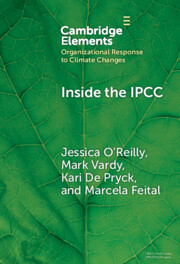1074 results
Chapter 2 - The Physical Environment
- from Part I - Introduction and the Physical Environment
-
- Book:
- Ecology in Action
- Published online:
- 04 April 2024
- Print publication:
- 04 July 2024, pp 20-51
-
- Chapter
- Export citation
Introduction
-
- Book:
- Feral Empire
- Published online:
- 30 May 2024
- Print publication:
- 06 June 2024, pp 1-13
-
- Chapter
- Export citation

Inside the IPCC
- How Assessment Practices Shape Climate Knowledge
-
- Published online:
- 03 June 2024
- Print publication:
- 20 June 2024
-
- Element
-
- You have access
- Open access
- HTML
- Export citation
12 - Shareholders and ESG Disclosure
- from Part III - Are Social Welfare Outcomes Any Different?
-
- Book:
- Hard Lessons in Corporate Governance
- Published online:
- 23 May 2024
- Print publication:
- 30 May 2024, pp 258-288
-
- Chapter
- Export citation
17 - Composition and Ecological Listening
- from Part III - Styles, Conventions, and Issues
-
-
- Book:
- The Cambridge Companion to Composition
- Published online:
- 25 May 2024
- Print publication:
- 30 May 2024, pp 270-284
-
- Chapter
- Export citation
2 - The Logic of Sustainable Development
- from Part I - Mise en Scène
-
- Book:
- Sustainable Development, International Law, and a Turn to African Legal Cosmologies
- Published online:
- 16 May 2024
- Print publication:
- 23 May 2024, pp 49-104
-
- Chapter
- Export citation
Chapter 35 - Goethe and Our Endangered Natural World
- from Part VI - Goethe’s Lasting Significance
-
-
- Book:
- Goethe in Context
- Published online:
- 16 May 2024
- Print publication:
- 23 May 2024, pp 341-349
-
- Chapter
- Export citation
Chapter 15 - Practical Socialism
- from Part IV - Movements and Causes
-
-
- Book:
- The Cambridge Companion to William Morris
- Published online:
- 03 May 2024
- Print publication:
- 23 May 2024, pp 203-214
-
- Chapter
- Export citation
Chapter 18 - Landscape and Environment
- from Part IV - Movements and Causes
-
-
- Book:
- The Cambridge Companion to William Morris
- Published online:
- 03 May 2024
- Print publication:
- 23 May 2024, pp 245-256
-
- Chapter
- Export citation
Mites, Mildew and Anheuser-Busch: How Pests, Big Beer, and Hops Shaped the Craft Brewing Industry
-
- Journal:
- Enterprise & Society , First View
- Published online by Cambridge University Press:
- 21 May 2024, pp. 1-26
-
- Article
- Export citation
Chapter 1 - Pandemics and the Lesson of History
-
-
- Book:
- The Cambridge Companion to American Utopian Literature and Culture since 1945
- Published online:
- 09 May 2024
- Print publication:
- 16 May 2024, pp 23-40
-
- Chapter
- Export citation
7 - Rachel Carson’s America
-
- Book:
- How Government Built America
- Published online:
- 08 May 2024
- Print publication:
- 09 May 2024, pp 79-93
-
- Chapter
- Export citation
13 - Australia in World Environmental Affairs
- from Part III - Issues
-
-
- Book:
- Australia in World Affairs 1996–2000
- Published online:
- 04 May 2024, pp 164-177
-
- Chapter
- Export citation
24 - Variation in Gesture: A Sociocultural Linguistic Perspective
- from Part V - Gestures in Relation to Interaction
-
-
- Book:
- The Cambridge Handbook of Gesture Studies
- Published online:
- 01 May 2024
- Print publication:
- 18 April 2024, pp 616-640
-
- Chapter
- Export citation

Islam and Environmental Ethics
-
- Published online:
- 13 April 2024
- Print publication:
- 09 May 2024
-
- Element
- Export citation
Chapter 3 - Elderly-Friendly Care Settings and Hospitals
-
-
- Book:
- Handbook of Old Age Liaison Psychiatry
- Published online:
- 04 April 2024
- Print publication:
- 11 April 2024, pp 38-43
-
- Chapter
- Export citation
Chapter 5 - Privacy and Dignity in Acute Hospitals
-
-
- Book:
- Handbook of Old Age Liaison Psychiatry
- Published online:
- 04 April 2024
- Print publication:
- 11 April 2024, pp 59-69
-
- Chapter
- Export citation
The impact of social-environmental factors on IQ in syndromic intellectual developmental disabilities
-
- Journal:
- Journal of Clinical and Translational Science / Volume 8 / Issue 1 / 2024
- Published online by Cambridge University Press:
- 05 April 2024, e59
-
- Article
-
- You have access
- Open access
- HTML
- Export citation
9 - Land Reform and Beyond in Times of Social–Ecological Change
- from Part II - Potentials and Pitfalls of South African Land Reform
-
-
- Book:
- Beyond Expropriation Without Compensation
- Published online:
- 28 March 2024
- Print publication:
- 04 April 2024, pp 214-238
-
- Chapter
-
- You have access
- Open access
- HTML
- Export citation
6 - Materials, Environment, and the Application of Knowledge
-
- Book:
- Creolised Science
- Published online:
- 03 April 2024
- Print publication:
- 04 April 2024, pp 183-211
-
- Chapter
- Export citation



